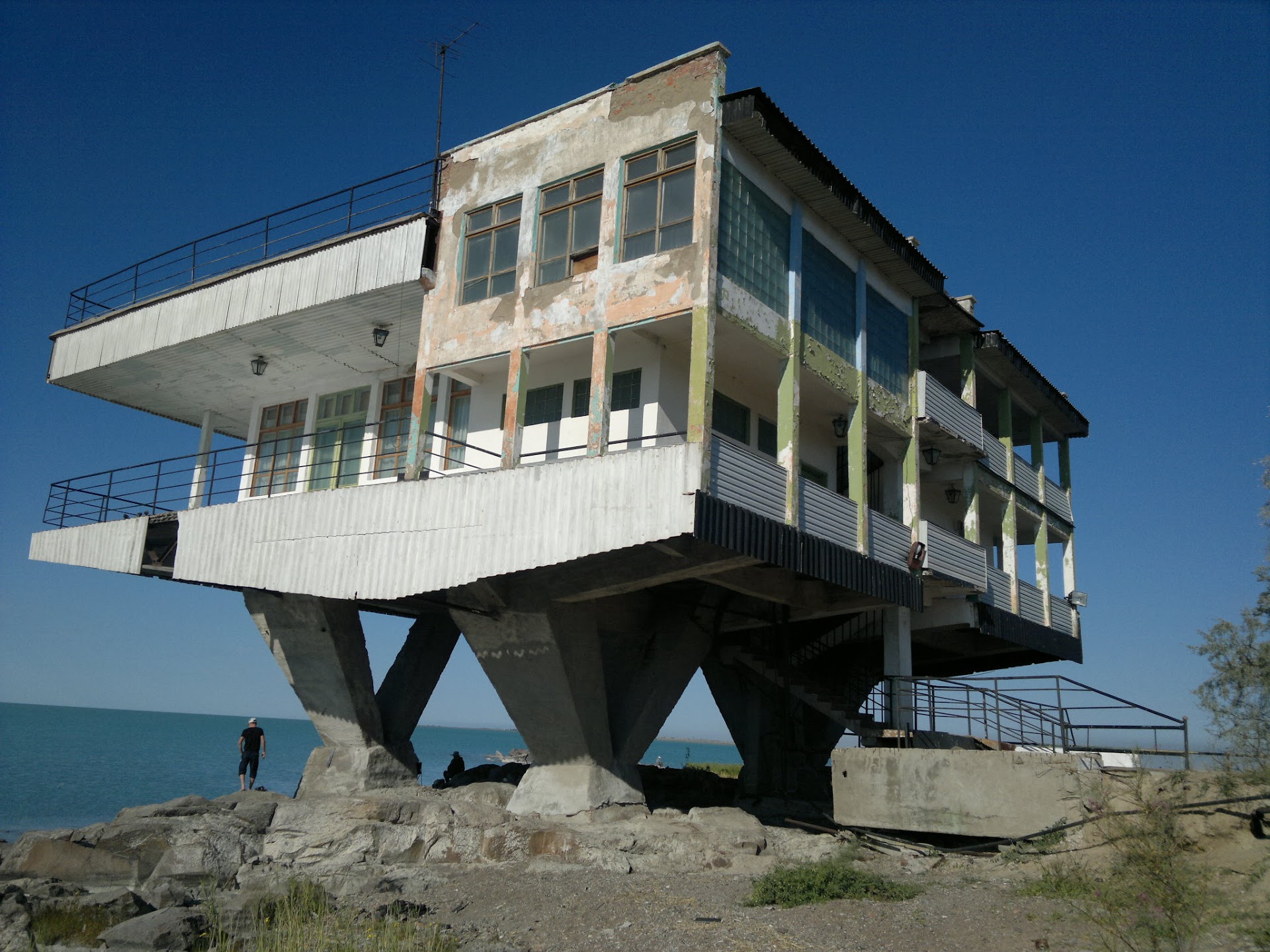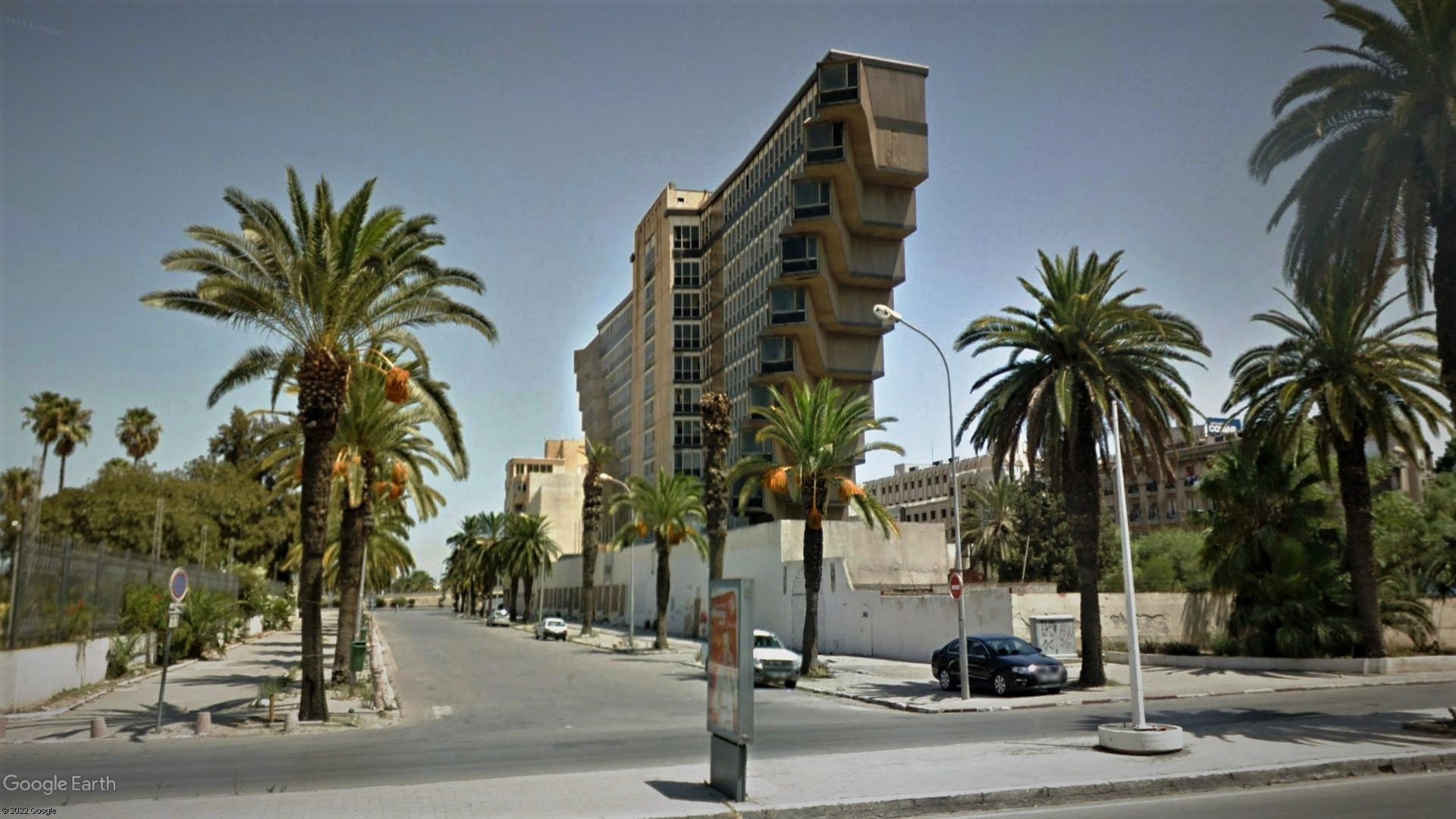Post by syzygy on Mar 2, 2022 15:31:28 GMT
Few hours ago I have spotted a monstrous building, checking a GE Photo on the shores of Lake Balkhash, Kazakhstan.

Rest zone building (Poplavok Fishery), Balkhash
GE Photo by SnakeSolid Krg
--
'Brutalism' - the word instantly has come to my mind... In the next few hours I have collected a boquet of such buildings from around the Globe - a few masterpieces of Brutalist architecture.
--
Two more examples from the collection:

Hotel du Lac, Tunis
GMaps SV link
--

Bank of Georgia, Tbilisi
GE BlueDot Photo by Oleg Zhuravlev / single image link
--
Recent stage of updates -- Placemarks for 8 buildings* in attached kmz folder:
Brutalism.kmz (3.74 KB)
Notes:
Double click on items! - Placemarks are set to proper StreetView frames where it was possible, also many site-specific, further infos available following links in description balloons.
*You'll find an odd one out inside, however I think also you'll admit, it is not that odd among the others... ( :
--
P.S.: Just have passed my 2000th posting around these new boards of the GEC, ...and this is Brutalist!


Rest zone building (Poplavok Fishery), Balkhash
GE Photo by SnakeSolid Krg
--
'Brutalism' - the word instantly has come to my mind... In the next few hours I have collected a boquet of such buildings from around the Globe - a few masterpieces of Brutalist architecture.
Brutalist architecture is an architectural style which emerged during the 1950s in the United Kingdom, among the reconstruction projects of the post-war era. Brutalist buildings are characterised by minimalist constructions that showcase the bare building materials and structural elements over decorative design. The style commonly makes use of exposed, unpainted concrete or brick, angular geometric shapes and a predominantly monochrome colour palette; other materials, such as steel, timber, and glass, are also featured.
Descending from the modernist movement, Brutalism is said to be a reaction against the nostalgia of architecture in the 1940s. Derived from the Swedish phrase nybrutalism, the term "New Brutalism" was first used by British architects Alison and Peter Smithson for their pioneering approach to design. The style was further popularised in a 1955 essay by architectural critic Reyner Banham, who also associated the movement with the French phrases béton brut ("raw concrete") and art brut ("raw art"). The style, as developed by architects such as the Smithsons, Hungarian-born Ernő Goldfinger, and the British firm Chamberlin, Powell & Bon, was partly foreshadowed by the modernist work of other architects such as French-Swiss Le Corbusier, Estonian-American Louis Kahn, German-American Ludwig Mies van der Rohe, and Finnish Alvar Aalto.
In the United Kingdom, Brutalism was featured in the design of utilitarian, low-cost social housing influenced by socialist principles and soon spread to other regions around the world. Brutalist designs became most commonly used in the design of institutional buildings, such as universities, libraries, courts and city halls. The popularity of the movement began to decline in the late 1970s, with some associating the style with urban decay and totalitarianism
Brutalism has been polarising historically; specific buildings, as well as the movement as a whole, have drawn a range of criticism (often being described as "cold" or "soulless"), but have also elicited support from architects and local communities (with many brutalist buildings having become cultural icons, sometimes obtaining listed status). In recent decades, the movement has become a subject of renewed interest. In 2006, several Bostonian architects called for a rebranding of the style to "Heroic architecture" to distance itself from the negative connotations of the term "brutalism".
More from source: en.wikipedia.org/wiki/Brutalist_architecture
Descending from the modernist movement, Brutalism is said to be a reaction against the nostalgia of architecture in the 1940s. Derived from the Swedish phrase nybrutalism, the term "New Brutalism" was first used by British architects Alison and Peter Smithson for their pioneering approach to design. The style was further popularised in a 1955 essay by architectural critic Reyner Banham, who also associated the movement with the French phrases béton brut ("raw concrete") and art brut ("raw art"). The style, as developed by architects such as the Smithsons, Hungarian-born Ernő Goldfinger, and the British firm Chamberlin, Powell & Bon, was partly foreshadowed by the modernist work of other architects such as French-Swiss Le Corbusier, Estonian-American Louis Kahn, German-American Ludwig Mies van der Rohe, and Finnish Alvar Aalto.
In the United Kingdom, Brutalism was featured in the design of utilitarian, low-cost social housing influenced by socialist principles and soon spread to other regions around the world. Brutalist designs became most commonly used in the design of institutional buildings, such as universities, libraries, courts and city halls. The popularity of the movement began to decline in the late 1970s, with some associating the style with urban decay and totalitarianism
Brutalism has been polarising historically; specific buildings, as well as the movement as a whole, have drawn a range of criticism (often being described as "cold" or "soulless"), but have also elicited support from architects and local communities (with many brutalist buildings having become cultural icons, sometimes obtaining listed status). In recent decades, the movement has become a subject of renewed interest. In 2006, several Bostonian architects called for a rebranding of the style to "Heroic architecture" to distance itself from the negative connotations of the term "brutalism".
More from source: en.wikipedia.org/wiki/Brutalist_architecture
Two more examples from the collection:

Hotel du Lac, Tunis
GMaps SV link
--

Bank of Georgia, Tbilisi
GE BlueDot Photo by Oleg Zhuravlev / single image link
--
Recent stage of updates -- Placemarks for 8 buildings* in attached kmz folder:
Brutalism.kmz (3.74 KB)
Notes:
Double click on items! - Placemarks are set to proper StreetView frames where it was possible, also many site-specific, further infos available following links in description balloons.
*You'll find an odd one out inside, however I think also you'll admit, it is not that odd among the others... ( :
--
P.S.: Just have passed my 2000th posting around these new boards of the GEC, ...and this is Brutalist!



